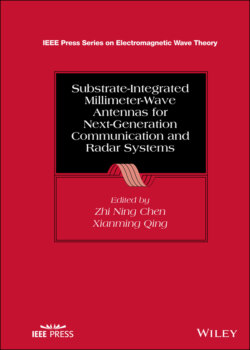Читать книгу Substrate-Integrated Millimeter-Wave Antennas for Next-Generation Communication and Radar Systems - Группа авторов - Страница 28
1.7 Note on Losses in Microstrip‐Lines and Substrate Integrated Waveguides
ОглавлениеAs previously mentioned, to compensate for the path‐loss at higher frequencies, usually very large‐scale antenna arrays are required in mmW systems. In such large‐scale antenna arrays the feeding network inevitably becomes complicated with a labyrinth of feeding network. The long current or power paths in the network are the critical causes for transmission losses. The additional unignorable transmission losses may be the stopper to limit the achievement of high gain of larger‐scale antenna arrays when the insertion loss cancels the increase in the gain by increasing the number of the elements of arrays. For example, if the insertion loss caused by the increase of the power path of the feeding network reaches nearly 3 dB, the antenna array with doubled number of elements will achieve very little gain enhancement. Therefore, it is important to check the transmission line systems in terms of insertion loss before the design of the arrays at mmW bands.
Next, the insertion losses in microstrip‐lines (MSLs) and SIWs in LTCC at 60 GHz are compared as an example. The LTCC is Ferro A6‐M with relative dielectric constant εr = 5.9 ± 0.20, loss tangent tanδ = 0.002 at 100 GHz. The conductor used for metallization and vias is Au, whose conductivity is 4.56 × 107 S·m−1.
Figure 1.6 shows a 10‐mm long bent MS transmission line on an LTCC board. The 50‐Ω MSL is with two ports in the simulation. Figure 1.7 compares the insertion losses for varying thickness of the LTCC board over a frequency range of 0–70 GHz. It is seen that when the thickness increases, the insertion at higher frequency edge quickly increases. For instance, the loss per centimeter reaches up to 13 dB when the thickness is larger than 0.7 mm.
Figure 1.8 clearly shows the causes of the insertion losses at higher frequencies or mmW bands. The losses caused by the dielectric substrate and conductor in the system are just a small percentage of the total losses. It is believed that at 60 GHz, the higher‐order modes excited by the discontinuity of the MS cause large surface wave (SW)/leaky losses as previously discussed. This issue is even severer for the thicker substrate. So the SW of MS at mmW is definitely a big problem for practical antenna design.
Figure 1.9 shows a 10‐mm long bent SIW in an LTCC board. Figure 1.10 shows the main losses at 60 GHz of a bent SIW in an LTCC board with varying thickness. It is clear that on the contrary, the SIW system does not suffer from such a dilemma, with the highest loss less than 1 dB per centimeter at smaller thicknesses and total losses lower than 0.6 dB for a thickness larger than 0.3 mm. The low‐loss feature is quite stable for all the thicknesses. But actually for the very thin thickness of 0.1 mm, the conductor loss is high for the SIW. Fortunately, the thickness of 0.5 mm is usually selected for SIW at 60 GHz. In particular, the majority of losses are caused by both the dielectric and conductors, which is different from the MS lines.
Figure 1.6 A bent MS transmission‐line on a LTCC board.
Figure 1.7 The comparison of |S11| and |S21| of a bent MS transmission‐line on a LTCC board.
Figure 1.8 The main losses at 60 GHz of a bent MS transmission‐line on a LTCC board with varying thickness.
Figure 1.9 A 10‐mm long bent SIW in a LTCC board.
Figure 1.10 The main losses at 60 GHz of a bent SIW in a LTCC board with varying thickness.
In short, the SIW transmission line systems feature lower insertion loss at 60 GHz and above compared with the MS‐lines suffering from several surface wave losses. However, it should be mentioned that the SIW has a more complicated fabrication and higher fabrication cost compared with the MS lines. The evaluation of performance and implementation cost is necessary to make a trade‐off in the design.
